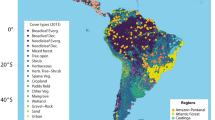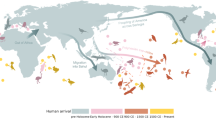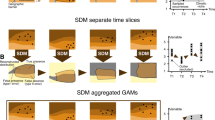Abstract
Arising from: D. L. Roberts & A. R. Solow Nature 426, 245 (2003).10.1038/426245a Roberts and Solow1 have presented theoretical data to suggest that the dodo, Raphus cucullatus, of Mauritius may have persisted until 1690, some 28 years beyond its accepted extinction date of 1662. Here we analyse new historical data derived from records of hunting caches, noted by Opperhoofd (Chief) Isaac Joan Lamotius, which confirm that specimens of R. cucullatus were collected regularly for at least 26 years beyond 1662. We calculate a new extinction date, which differs by only three years from that calculated by Roberts and Solow, but which, using a statistical treatment similar to theirs, greatly narrows the confidence interval.
Similar content being viewed by others
Main

The last accepted record of the dodo is that from the shipwrecked mariner Volkert Evertszoon, who in 1662 walked on to an islet that supported a small population of dodos2. In 1674, however, Commandeur Hubert Hugo questioned a recaptured slave called Simon, who had seen dodos on two occasions3 during his time at large, between 1663 and 1674. Previously unreported is a note4 that hunters captured and killed dodo and other endemic prey for Hugo on 16 August 1673.
Following Hugo, Lamotius became Opperhoofd of Mauritius from 1677 to 1692 and he recorded events on the island in a series of diaries. During the first few years of his command, Lamotius was supplied with ample provisions from the Cape (South Africa) and so did not regularly send out hunting parties. But diaries from 1685 to 1688, which are held in the Cape Archive, suggest that Mauritius received little support during those years from either the Cape or the Netherlands5. Over that period, Lamotius dispatched hunters daily to obtain food, and he maintained a day-by-day account of their quarry6.
Although the importance of this document has been realized for some time7, its reliability has been questioned2. Consequently, Roberts and Solow1 excluded these records in their analysis of the dodo's demise. Lamotius records dodo (as “dodaersen”) on 12 separate occasions as part of the hunters' quarry during the period 1685–88 (ref. 6).
As endemic species became rarer, the quarry mainly comprised animals that had been introduced to the island such as deer, pigs and goats. Ducks, geese and flamingos were abundant at certain times of the year, but only very rarely did the catch include the now extinct Mauritian giant tortoise (Cylindraspis spp.) or the dodo. Lamotius last recorded the capture of a dodo on 25 November 1688.
A problem raised over Lamotius's accounts is his use of the term dodaersen. Cheke2 maintains that this name was transferred from the dodo to another flightless endemic Mauritius bird, the red rail (Aphanapteryx bonasia), which was much smaller and had a slender beak — quite different from the massive bill of the dodo.
We consider it much more likely that Lamotius was using the name dodaersen to refer to the dodo. He was a credible observer, having been instructed by the Dutch East India Company to record, among other things, the natural history of Mauritius. He compiled a list of endemic trees and their medicinal uses on the island, and sent botanical specimens to the gardens of the company at the Cape; he was also an inventor and draughtsman3. Lamotius would have been well acquainted with the distinctive morphology of the dodo because of its fame in western Europe — at least three specimens had been transported to the Netherlands and many paintings were in existence, predominantly by Dutch artists.
For these reasons, it is unlikely that Lamotius would have confused the red rail with a dodo. The Dutch were familiar with rails and rail-like birds in their home territory, calling them velt-hoenders, meerkoet and waterhoen. There is no mention of these in the accounts of either Hugo or Lamotius, whereas earlier Dutch accounts do refer to the red rails of Mauritius as velt-hoenders (field chickens)2. There is no evidence that Lamotius or Hugo changed this name to dodaersen.
The dates derived from the dodo records of Lamotius and the new records of Hugo confirm that the dodo was present on Mauritius at a time close to the estimated extinction time of 1690 that Roberts and Solow calculate1. This date has a 95% confidence interval of 1669 to 1797, calculated from their record of reported observations covering 1598–1662. Using the same statistical analysis1 and all the observations together, including the new dates of Hugo and the records of Lamotius (up to 1688), we estimated the likely duration of isolated populations of dodos beyond the last records of Lamotius. We calculate a new estimated extinction date of 1693, with a 95% confidence interval of 1688 to 1715, a period of only 27 years. Our data set comprises 16 observations, and the last four occur within a four-year period.
Although our data have extended the estimated extinction time by only three years, our 95% confidence interval is considerably narrower (27 years as opposed to 128 years). This is due in part to a change in methods of data collection in that period: records seem to be ad hoc before 1685, but then observations become more frequent because of the need to hunt food.
Lamotius's hunting record ceased in 1688 because he became despondent, it is believed7; a diary for 1689 cannot be located; and Lamotius was arrested and left the island in 1692. Although the Dutch have been blamed for the final extinction of the dodo, we note that the time interval from 1688 to the time of the French takeover of Mauritius in 1710 (ref. 7) lies within the 90% confidence interval for the estimated extinction time. There is thus a 10% chance that the dodo became extinct during the French occupation of Mauritius.
References
Roberts, D. L. & Solow, A. R. Nature 426, 245 (2003).
Cheke, A. S. Studies of Mascarene Island Birds (ed. Diamond, A. W.) 5–89 (Cambridge University Press, Cambridge, 1987).
Pitot, A. T'Eylandt Mauritius. Esquisses Historiques (1598–1710). Précédés d'une notice sur la découverte des Mascareignes et suivres d'une monographie du dodo, des solitaires de Rodrigue et de Bourbon et de l'oiseaux bleu (Port Louis, Mauritius, 1905).
Hugo, H. Letter from Hugo to the Cape Commander. Archive of the Political Council, C293 (Cape Archives, South Africa, 1674).
Sleigh, D. The Economy of Mauritius during the Second Dutch Occupation (1664–1710) in Globalization and the Southwest Indian Ocean: Mauritius and Neighbouring Islands (Proc. Int. Sem. 21–23 September 1998).
Lamotius, I.J.J. Dag-register van't principale gepasseerde op't Eyland Mauritius gehou'den byj opperhooft Isaac Joan Lamotius gebinnende mit den 1st January 1685–1688. Archive of the Political Council, C2238, C2239, C2240 (Cape Archive, South Africa, 1685–1688).
Moree, P. A Concise History of Dutch Mauritius, 1598–1710: A Fruitful and Healthy Land (Kegen Paul, London and New York, 1998).
Author information
Authors and Affiliations
Corresponding author
Rights and permissions
About this article
Cite this article
Hume, J., Martill, D. & Dewdney, C. Dutch diaries and the demise of the dodo. Nature 429, 1 (2004). https://doi.org/10.1038/nature02688
Issue Date:
DOI: https://doi.org/10.1038/nature02688
This article is cited by
-
Digging for dodo
Nature (2006)
Comments
By submitting a comment you agree to abide by our Terms and Community Guidelines. If you find something abusive or that does not comply with our terms or guidelines please flag it as inappropriate.



